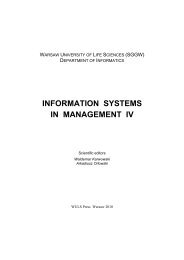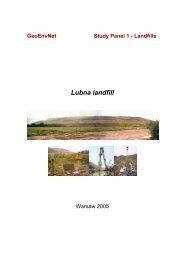ACTA SCIENTIARUM POLONORUM - SGGW
ACTA SCIENTIARUM POLONORUM - SGGW
ACTA SCIENTIARUM POLONORUM - SGGW
You also want an ePaper? Increase the reach of your titles
YUMPU automatically turns print PDFs into web optimized ePapers that Google loves.
22 R. Hryniewski, W. Mądry, D. Gozdowski, B. Roszkowska-Mądraet al. 2010]. Poland is the second largest producer of tobacco leaves in Europe, cultivatingprimarily light cigarette tobacco. At present, about 60 thousand farmers are involved in thenational production of tobacco leaves, which is carried out in about 14 thousand farms, onan area of 17.1 thousand ha. Tobacco is mainly grown in some parts of south-eastern Poland,i.e. the provinces of Lubelskie, Podkarpackie, Mazowieckie and Świętokrzyskie.The production of tobacco leaves and its profitability are becoming consistently moreand more uncertain, both in the world and in Poland. The global and domestic trends withrespect to the level and stability of public subsidies for tobacco production are markedlydecreasing [Altman et al. 1996, 1998, Fisher 2000, Warner 2000, Chavez et al. 2010]. Underthese circumstances, tobacco growers in many countries, including Poland, are at thecrossroads [Geist et al. 2009]. This generates a serious threat to the continuity of tobaccoproduction in the country and to sustainable farming, and even to the survival of a numberof tobacco farms, especially the less prosperous ones. In some developed countries vigorousattempts are made to create concepts of various forms of interventions by the state,local governments, tobacco companies, and also by central and local agricultural organizations,which can effectively support the tobacco farmers facing the negative effects ofexternal threats for multi-functional and sustainable agriculture [Altman et al. 1996, 1998,Fisher 2000, Warner 2000, Geist et al. 2009, Chavez et al. 2010]. Following the example ofother countries, it would be desirable to take similar supporting activities in Poland, too.One of the most important conditions for ensuring high effectiveness of public interventionsin agriculture and rural areas is its flexibility, that is, the creation and implementationof various options of support by the European Union, the state and local governments,suited to diverse (specific) farming systems in the area under consideration [Gibonet al. 1999, Caballero 2001, Dixon et al. 2001, Pardos et al. 2008, Blazy et al. 2009, Roszkowska-Mądra2010]. This strategy of support interventions requires an assessment of thediversity and identifying types of farming systems (typology of the farming systems) inthe respective study areas [Landais 1998, Duvernoy 2000, Köbrich et al. 2003, Blazy etal. 2009, Carmona et al. 2010, Chavez et al. 2010, Zawadka 2010].The aim of this paper is to analyze the diversity in diagnostic variables that are characteristicof the farming systems (holistic description of agricultural production, non-agriculturalactivity and resources in farm households) in tobacco farms within south-easternPoland, and to identify the typology of these systems with multivariate statistical methods,mainly for generating recommendation domains in farming systems research, e.g. to determininginnovative structural and developmental adjustments in the identified types offarming systems and also for planning options of supporting these adaptation processes.MATERIALS AND METHODSThe studied tobacco farms are located in three provinces of south-eastern Poland, i.e.Lubelskie, Podkarpackie and Mazowieckie, although in the last one there are only a fewfarms of this kind in its south-eastern part (Figure 1). In the last few years, about 50% of tobaccogrown in Poland has been produced in the Lubelskie and Podkarpackie provinces.The size of the population of the tobacco farms covered by the research in the provincesof Lubelskie, Podkarpackie and Mazowieckie in 2009 was 1133. From this popu-Acta Sci. Pol.
















